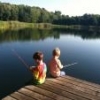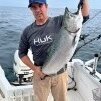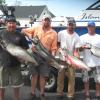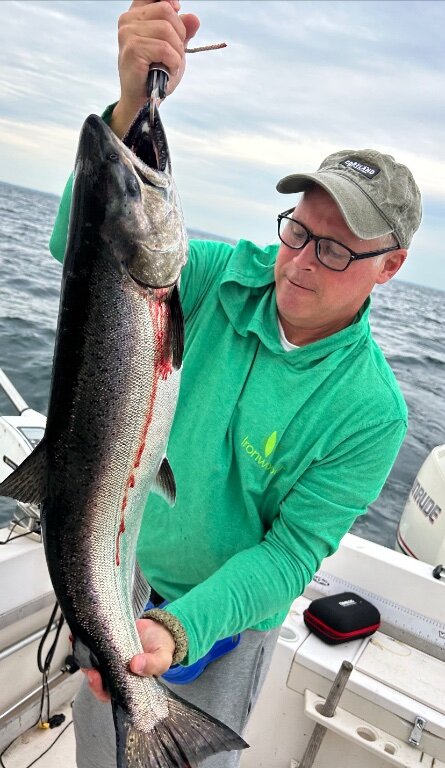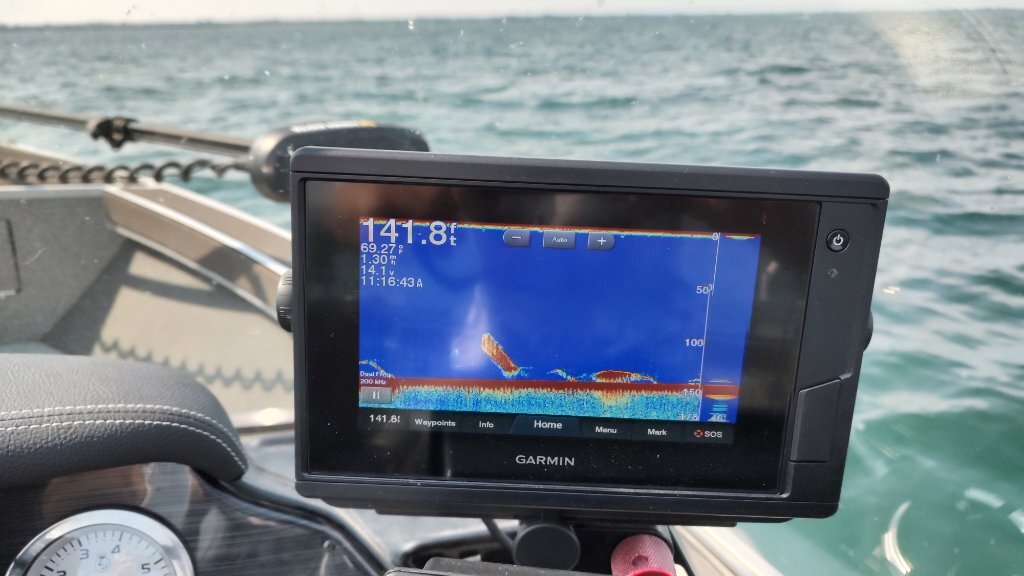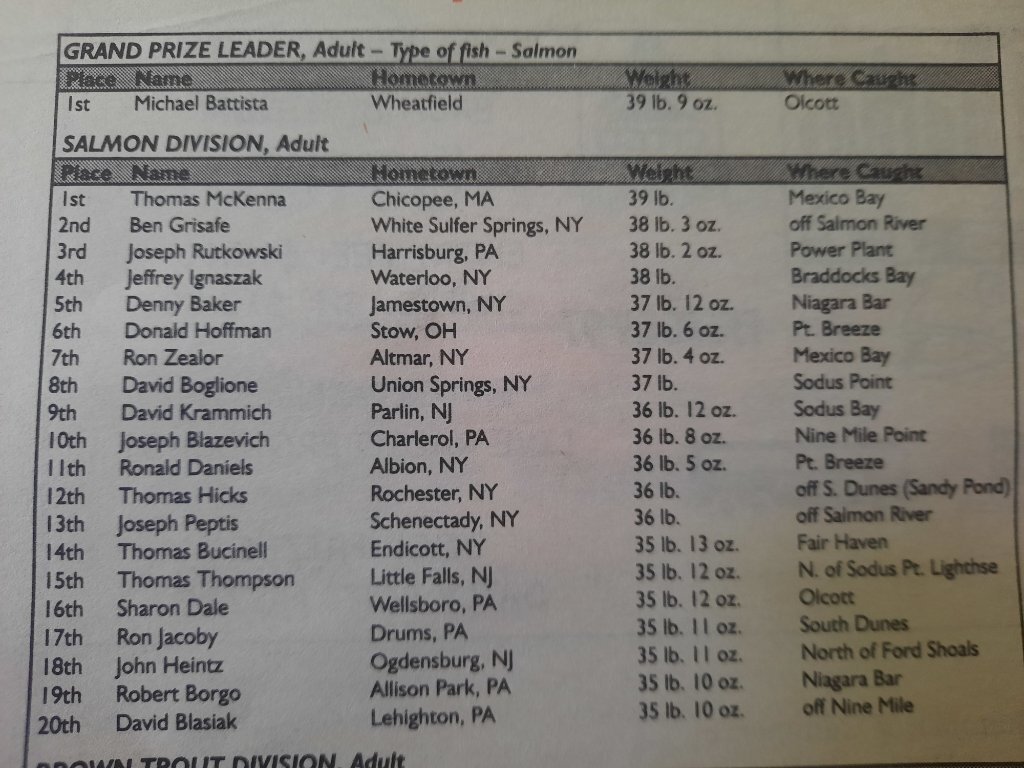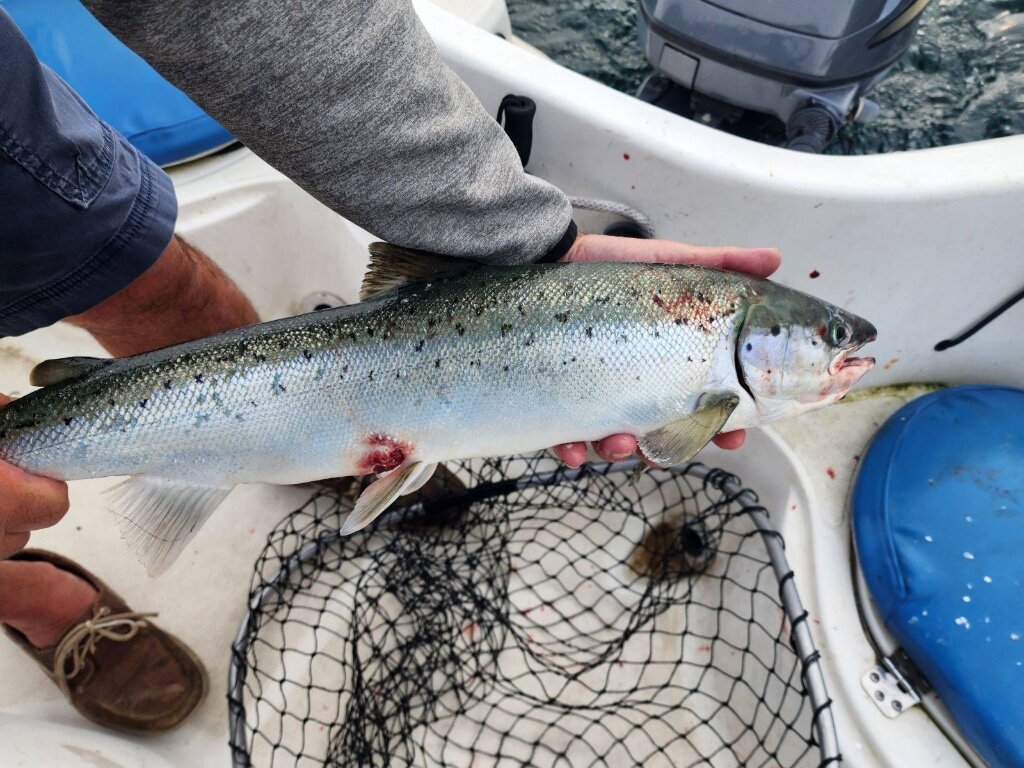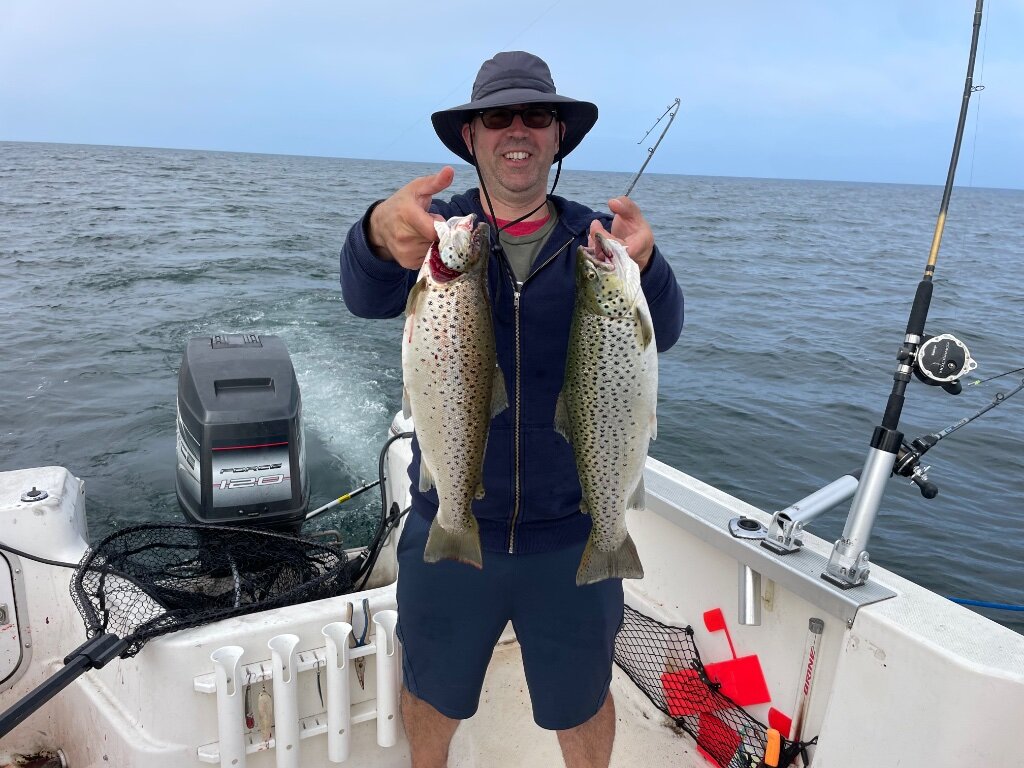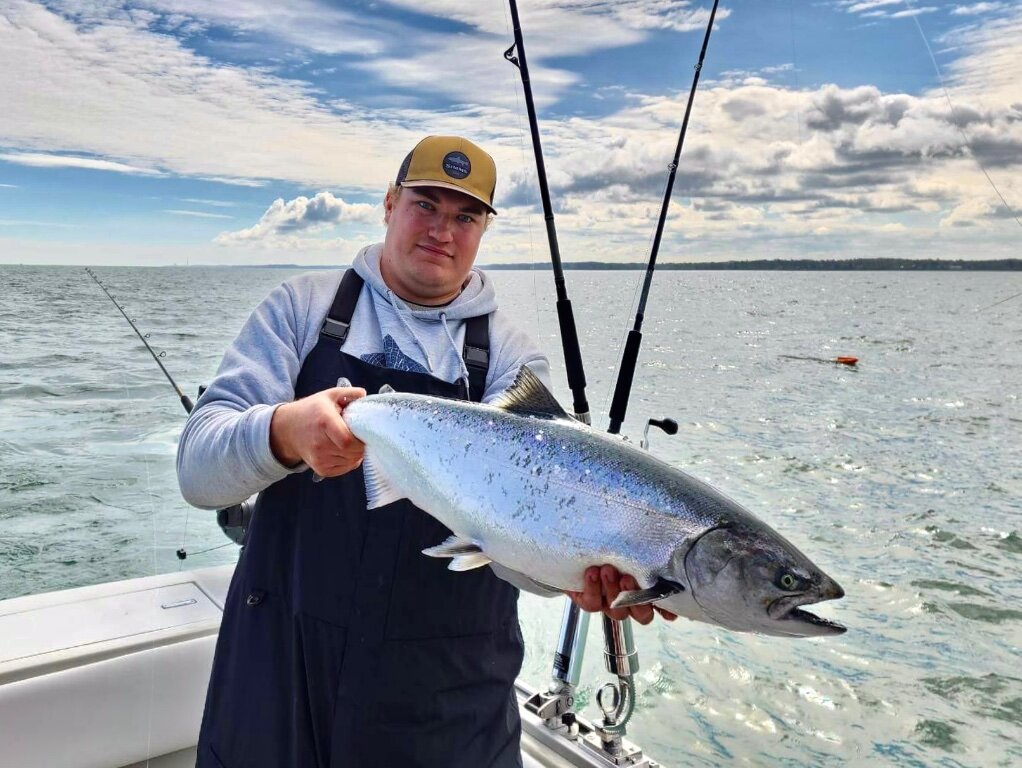

Sweet Caroline
Members-
Posts
500 -
Joined
-
Last visited
Sweet Caroline's Achievements
92
Reputation
-

heaviest LO King this year, how
Sweet Caroline replied to schreckstoff's topic in Open Lake Discussion
My thought is we will have a good amount of 4 yr olds this year because the record 3 year old class we had last year. Could be some decent kings, compared to most years. A few of these older fish should hit the leader board. Maybe 1 in 100 compared to 1 in 500 in other years lol -
A few thoughts: 1. Regardless of the age make up of mature fish that are in the system, are 2, 3 4 yr olds smaller now then they were 10-20-30 years ago? Seems like LO chinooks are maturing earlier, but there is still enough of a sample to determine if the same age fish now are actually smaller then they were back then. 2. I don’t think that just because a salmon is caught in Canada means it was hatched in Canada, unless it was caught in or near a river in the Fall. Most of those large tourney fish were caught in the Summer months when Salmon are still wandering all over the lake. I think tagging studies clearly showed that salmon travel up and down and back and forth all over the lake up until they start honing in on their spawning streams late Summer and Fall. They travel thousands of miles in the ocean. LO is a fish bowl compared to that. I think a better test would be to see if the mature fish in the stream are larger in Canada then on our side. This way you pretty much know they were hatched there. 3. To determine if it is a bait or over population issue a good test would be to greatly reduce or stop stocking to see if size increases. I’m sure nobody wants to do that nor do I. I believe Lake Michigan did do that to a certain extent and did see a size increase. 4. I don’t think the cherry picking of large fish by fishermen on the salmon River before they make it to the hatchery has a major impact. Salmon move quite a bit at night and many still make it. Based on the amount of salmon I see at the hatchery it would seem hard to believe that there are no big boys that make it through the gauntlet. 5. From a pure logical perspective it would seem to be a no brainer to collect as many eggs and milt as you can from the largest fish that make it to the hatchery. Large parents usually have large kids, All this just my opinion of course. Nice, healthy debate fellas and an interesting read.
-
Could be that all the 3 year olds are pushing everything else out of the prime water. I’ve found that when we are catching so many 3 year olds like we are now you pretty much don’t catch much of anything else. They are super aggressive and tend to travel together in packs….or call it hordes this year. Sounds like boats that venture out of the prime zone catch more of a mixed bag. IDK, just an observation and theory. I also agree, too many mouths to feed to support a trophy fishery. Even with all the bait that is a lot of competition and more energy burned to chase them. I feel that the same environmental conditions that support a good alewife hatch also support good king natural reproduction. Wasn’t it the 2021 or 202 bait hatch that was insane? All theory’s of course. Only Mother Nature knows for sure. We certainly could have worse problems than too many fish to catch lol
-
To me , logic tells me high catch rates and smaller size are indicative of a lower bait population. Simply put, the fish are more numerous and with less food to share, therefore they will bite your bait more regularly. I believe steelhead, browns and coho sizes are all lower as well on average. Those fish do have a more diverse diet so maybe not as impacted as much as chinook, but still a noticeable difference in weight of those fish compared to past years. Is genetics also affecting the size of browns, steelhead, cohos? I understand there are less 3 year olds, but there still are some, so what is the weight comparison of today’s 3 year olds to those of 20 years ago? If it is not a bait problem, then the size should have stayed about the same. Selecting only the larger, 3 and 4 year old fish at the hatchery certainly wouldn’t hurt. Not sure that is possible to still hit the stocking numbers we need. I don’t think that is the main culprit though. Again, we still have 3 olds, albeit not as many, but I’m pretty sure the size is down for the ones we have compared to the 3 olds of years past. Any genetic reintroduction would have to select for slower maturing fish of 3-5 years instead of the 2-3 we have now. Or a faster growing fish. Not sure if either exists. The chinook we have today I’m certain have evolved. I.e less time staging in warm water, runs later in the fall and probably more natural reproduction then we had when they were first introduced. The Genny is not loaded with floaters anymore in early September like it was in the 80s, early 90s. I’m sure size has evolved a bit too, selecting for smaller and faster maturing fish of only 2 years, rather then 3-4. Also makes for a very unpredictable fisheries management given the variability of natural reproduction from year to year. We have a great fishery, but I’ve pretty much given up on ever catching a 30 plus pound king again. I’m happy with anything over 20 now. I hate to say it but if weights keep going down the thrill is just not going to be there for me anymore regardless of how many salmon I catch in a morning. I know there has to be a balance. Can’t have your cake and eat it too. Don’t want to struggle to catch 5 fish, but don’t need to regularly catch 20 plus either. We seemed to have a decent balance around 2007 or so, when you could catch double digits with some big ones mixed in. DEC has tough job of quantity vs quality for sure.
-

DEC meeting on bass in Abay-rescheduled for 3/14
Sweet Caroline replied to Lotalota's topic in Open Lake Discussion
-

Genny Wednesday am …,
Sweet Caroline replied to Bustersit's topic in New York Fishing Reports - Lake Ontario (South Shore)
-
Little better to the East off Ibay. We dropped in at the 25N and made it to the 31.5N. Temp and fish 100-120 down. Temp came up above 90 around 30N but screen dried up. Best water for us 27N - 28N with a good mix of steelies, 2 year olds and matures. No LOC fish though. We did donate a shark weight as well today!
-
Spot on about the zebra mussels. IMO the biggest factor causing bait declines. The lake was filthy with bait up until the early 90’s when zebra mussels took hold. Zebra mussels probably have leveled off now, but their continued existence, the low phosphorus loads and general cleaning of the the Great Lakes is making it hard for bait to bounce back to the levels we had. To consistently grow 30 and 40lb fish requires enormous amounts of bait. Fishing would not be as good as it is now if we had the amount of bait we had back then. Michigan has seemed to bounce back a bit with the size of their salmon, with the new Great Lakes record king being caught in recent years.Their salmon have been stocked before LO and have had plenty of time to evolve as our LO have. They experienced a huge decline in size for well over a decade but were able to bounce back. Gives me hope with our LO fish. I do believe there has to be a balance between quantity and quality for that to happen. Quantity is not something many folks are willing to sacrifice though. If I recall, some of the large high 30 and 40lb salmon caught on the Canadian side of LO in recent years were rare 4 yr old fish. Selecting for larger and older size Kings at the hatchery is one thing we can do to keep size up given our current ecosystem. Not much we can do about everything else but that is one thing that is totally in our control. Again, if your parents and grandparents all lived to be 90 years old, it is likely you will live long too. I know, not a guarantee, but the odds are in your favor. Would make a huge difference if even 5% of our Kings could make it to 4 yrs. That said, is there any data on how many returns are 3 and 4 yr olds? Not sure if there is even enough returns of those age structures to get the eggs we need for stocking?
-

Ibay where did the fish go?
Sweet Caroline replied to 180ccf's topic in New York Fishing Reports - Lake Ontario (South Shore)
-
-
Just my opinion, but we have a lot of bait, but not nearly as much as we had in the 80s and early 90s. Seems like we have more salmon too, which decimate any good hatches we have pretty quickly. Not scientific, but high catch rates like we have now and smaller size usually indicate lower food supply. Granted we are all better fisherman now then we used to be, but back then it was rare to catch over 10 salmon in a morning. I think the salmon we have now have evolved in many ways to LO, part of it could be smaller size. I’m all for introducing new genetics. At the very least we should be taking eggs from the cream of the crop at the hatchery to help combat smaller size which makes the most sense to me. If a six foot tall man and woman had a baby, the baby most likely will be tall too. Pure logic on that one.
-
Sandy or Braddocks Bay would be more port of choice most of the year. Browns, Lakers, Kings all great fishing throughout the Summer.
-

Brown Trout Distribution in Lake O
Sweet Caroline replied to Jeff Mick's topic in Open Lake Discussion
Browns get hammered by just about everything when they are stocked. Cormorants have a field day on them for sure. They don’t move much for days and sometimes weeks after being stocked and are sitting ducks. Barge stocking seems like it would help. Has there ever been any research on barge stocked vs shore stocked survivability? The amount of money thrown out the window when these get stocked is sickening. Such a waste. Surprised we have as good of a brown fishery as we do given what I’ve witnessed. -

Brown Trout Distribution in Lake O
Sweet Caroline replied to Jeff Mick's topic in Open Lake Discussion
Nearshore structure are the best holding places for browns. Haven’t fished Oswego much but I believe there is some great shoreline down there. Browns in the lake tend to stay as close to shore as possible, temperature permitting, which is why areas with structure nearshore tend to produce better especially in Summer and Fall. In Spring, any warm water outlet or sometimes beaches can be good that warm faster. Structure areas will produce in Spring too, especially if there is a stream nearby that warms the water slightly. They can travel some long distance in the lake unlike when they are stocked in streams. Tagged browns in Canada have been found on the south shore. I think they settle more in areas with better structure that regularly hold bait around the lake as opposed to offshore salmon and steelhead that travel with the current and bait. Here in ROC, I’m going east or west if targeting browns and have not had great success with anything in between for browns, minus early Spring. In clear water in the Spring, I will target any water that has color no matter where it is. Hope that helps. -
I remember docking next to you and Gratson for a few years. Miss those days. Bigger boat now doesn’t allow me to travel around the lake like we used to. I learned a lot from our conversations. Your talent as a lake guy is way under rated compared to your trib fame. I see there are a lot of 2 year olds as expected.

